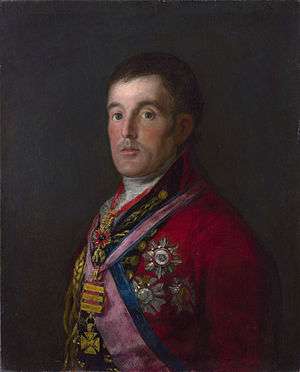Kempton Bunton

Kempton Cannon Bunton (April 1904 – 1976) was a disabled British pensioner who allegedly stole Francisco Goya's painting Portrait of the Duke of Wellington from the National Gallery in London in 1961.[1][2]
A National Archive file released in 2012 revealed that Kempton's son, John, had confessed to the theft in 1969.[3]
The motive
Bunton was a retired bus driver who earned £8 a week in 1961 (equivalent to £161 in 2015).[4][5] In that year, Charles Bierer Wrightsman, a rich American art collector who made his money in the oil business, purchased Goya's painting Portrait of the Duke of Wellington for the sum of £140,000 ($390,000). He had plans to take it to the United States.[6] The British Government decided to buy the painting, for the same sum, to prevent the painting leaving Britain. The move was reported to have enraged Bunton, however, who was embittered at having to pay the television licence fee from his modest income.[5]
Theft of the painting
According to his own account, from conversations with the gallery guards, Bunton learned that the elaborate electronic security system, of infrared sensors and alarms, was deactivated in the early morning to allow for cleaning. Bunton claimed that, on the early morning of 21 August 1961, he had loosened a window in a toilet and entered the gallery. He had then prised off the framed painting from the display and escaped via the window.[5]
The police initially assumed that an expert art thief was responsible. A letter was received by the Reuters news agency, however, requesting a donation of £140,000 to charity to pay for TV licences for poorer people and demanding an amnesty for the thief, for which the painting would be returned. The request was declined.
The theft entered popular culture, as is referenced in the 1962 James Bond film Dr. No, with the painting is displayed in Dr. No's lair.[6]
Return and prosecution
In 1965, four years after the theft, Bunton contacted a newspaper, and through a left-luggage office at Birmingham New Street railway station, returned the painting voluntarily. Six weeks later, he also surrendered to the police, who initially discounted him as a suspect, considering the unlikeliness of a 61-year-old retiree, weighing 17 stone (110 kg), executing the heist.[2][5]
During the subsequent trial the jury convicted Bunton only of the theft of the frame, which had not been returned. Bunton's defence team, led by Jeremy Hutchinson QC (also notable for his involvement on the defence team at the Lady Chatterley trial), successfully claimed that Bunton never wanted to keep the painting, thus meaning he could not be convicted of stealing it.[7] Bunton was sentenced to three months in prison.[5] Section 11 of the Theft Act 1968, which made it an offence to remove without authority any object displayed or kept for display to the public in a building to which the public have access, was enacted as a direct result of the case.[8]
In 1996 documents released by the National Gallery implied that another individual may have carried out the actual theft, and then passed the painting to Bunton. Bunton's son John was mentioned.[9]
In 2012 the National Archives released a confidential file from the Director of Public Prosecutions in which Bunton's son John confessed to the theft following his arrest in 1969 for an unrelated minor offence. John Bunton said that his father had intended to use the painting as part of his campaign and that it would ultimately have been returned to the National Gallery. He said that both he and his brother, Kenneth, had been ordered by their father not to come forward despite the trial.[3] Sir Norman Skelhorn, the Director of Public Prosecutions, told the police that John Bunton’s admission of guilt was almost certainly not sufficient to prosecute him. Skelhorn also advised that it would be difficult to prosecute Bunton senior for perjury as the prosecution would have to rely on the evidence of the son, who was clearly an unreliable witness. No further action was taken.[10]
Bunton died in Newcastle upon Tyne in 1976.[10]
References
- ↑ Greatest heists in art history, BBC, 23 August 2004.
- 1 2 Antonio Nicita and Matteo Rizzolli, "Screaming Too Mu(n)ch? The economics of art thefts", 18th Erfurt workshop on Law and Economics held on March 23 and 24, 2005.
- 1 2 Travis, Alan (30 November 2012). "Revealed: 1961 Goya 'theft' from National Gallery was a family affair". The Guardian.
- ↑ UK CPI inflation numbers based on data available from Gregory Clark (2016), "The Annual RPI and Average Earnings for Britain, 1209 to Present (New Series)" MeasuringWorth.
- 1 2 3 4 5 Sean P. Steele, "Swindles, Stickups, and Robberies", pp 74-78. ISBN 1-85627-706-2.
- 1 2 World's Greatest Art Heists, Forbes, September 1, 2006.
- ↑ Nairne, Sandy (6 August 2011). "From the National Gallery to Dr No's lair". The Guardian.
- ↑ Report: Ministerial Advisory Panel on Illicit Trade, British Department for Culture, Media and Sport, pp 15, December 2000.
- ↑ Art Theft Central: New Insights into an Old Art Theft
- 1 2 "Kempton Bunton and the Great Goya Heist at the National Gallery « Another Nickel In The Machine". Nickelinthemachine.com. 9 May 2014. Retrieved 5 January 2016.